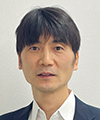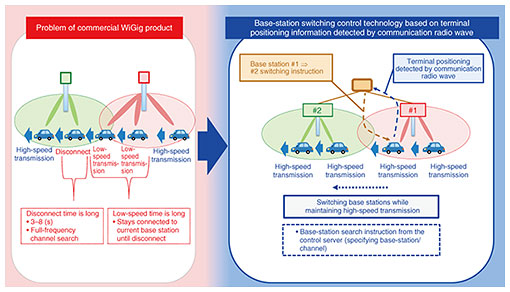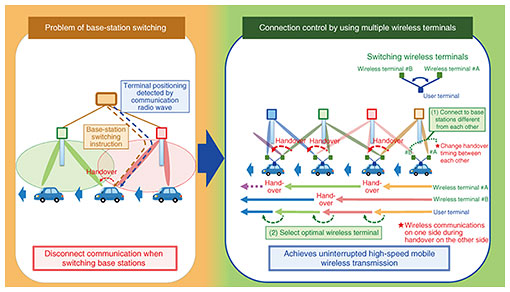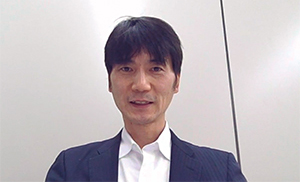 |
|
|
|
|
|
Rising Researchers Vol. 22, No. 6, pp. 11–17, June 2024. https://doi.org/10.53829/ntr202406ri1  High-frequency-band Distributed Antenna System Technology Exploring the Possibilities of Higher Frequency Bands for Mobile CommunicationsAbstractToday, as data capacity continues to increase, the demand for communications capable of higher transmission speeds and capacity is increasing. For sixth-generation mobile communication system (6G) wireless, which is scheduled to be put into practical use around 2030, extreme-high-speed and high-capacity communications with a wireless transmission speed of 100 Gbit/s or more per user is being discussed. To achieve this, new breakthrough wireless technologies are required. In this article, we spoke to NTT Distinguished Researcher Daisei Uchida about wireless technology that enables high-frequency bands to be comfortably applied to mobile communications. He talked about a high-frequency-band distributed antenna system for 6G. Keywords: high-frequency-band distributed antenna system, WiGig, 6G Technology for new higher frequency bands for a more comfortable communication society—Mr. Uchida, what exactly is “high-frequency-band distributed antenna system technology?” The demand for high-speed and high-capacity wireless communications is growing. “High-frequency-band distributed antenna system” is a promising technology to meet this demand. It can achieve stable high-speed and high-capacity wireless transmission by distributed multiple antennas from one base station when using high-frequency bands such as millimeter waves and sub-terahertz. To increase data capacity in the future, extreme-high-speed and high-capacity wireless communications of 100 Gbit/s or greater per user is being discussed to support an extensive range of use cases in the sixth-generation mobile communication system (6G) scheduled for launch around 2030. These use cases include high-definition, uncompressed video, three-dimensional information, extended reality (XR) data, and data related to the five human senses. One means of achieving these high speeds is to expand the wireless signal bandwidth from the conventional range of several 100 MHz to 1–10 GHz and to enable millimeter-wave and sub-terahertz high-frequency bands that can secure such bandwidth to be applied to mobile communications. In this way, we aim to realize extreme-high-speed and high-capacity wireless transmission, which has been difficult to achieve until now (Fig. 1).
—What are you specifically undertaking in high-frequency-band distributed antenna system technology? The first target problem that we had to deal with in achieving this technology is the “ease of interruption” of wireless communications in high-frequency bands. Compared with low-frequency bands, the advantage of high-frequency-band radio is that it can provide stable high-speed and high-capacity wireless transmission when radio wave propagation is unobstructed. Its disadvantage, however, is that radio waves are easily blocked by shielding objects, making wireless communications vulnerable to interruptions and difficult to use. Amid this advantage-and-disadvantage situation, I continued to have strong feelings about high-frequency-band radio such as “Certainly it would be useful to society if radio waves could be made to propagate freely, that is, if they could be made to fill the target area” and “I want radio waves to be useful to society.” As a result, a search has been going on for some kind of method that can resolve this dilemma. To this end, we are conducting research on distributed antenna technology that distributes the antennas radiating radio waves so that those signals can be transmitted from various directions. This technology has been studied since the 2010s in low-frequency bands. If radio waves are emitted from a base-station antenna at one location, the ease of interruption—the disadvantage of high-frequency bands—can easily occur. Consequently, in an environment in which reflected waves from all directions cannot be expected such as an outdoor or large-scale indoor environment, it is difficult to achieve stable high-speed and high-capacity communications in a mobile communications environment. On the other hand, if a distributed antenna technology could be achieved with a mechanism that distributes multiple antennas from a single base station so that a mobile terminal can be instantly switched to a more appropriate antenna at any time, it is thought that this problem of the ease of interruption of high-frequency bands could, in theory, be solved. Specifically, we are aiming to reduce the radio-wave blind areas through “passage” based on distributed antennas in a shielding environment. In this way, we aim to stably provide the potential for extreme-high-speed wireless transmission in high-frequency bands. One of the key points of this technology is that it communicates with one base station no matter which distributed antenna transmits and receives, rather than switching base stations as in the past. Ordinarily, when switching between base stations, it is necessary to perform a control process called handover in upper layer protocol. The antenna switching of the proposed technology, however, adopts a method that switches on Layer 1, the physical layer. In short, it adopts a mechanism that maintains the connection with a single base station regardless of which antenna is transmitting or receiving signals. Thus, if nearby people or a passing car, for example, should cause instantaneous shielding to occur, this mechanism based on physical control makes it possible to switch in an uninterrupted manner to an optimal antenna for which radio waves are not shielded. Moreover, given that this antenna-switching control process is confined to the base station, it can be performed seamlessly without placing a burden on the network side or terminal side. At the present stage of research, we are already conducting demonstration experiments in collaboration with NTT DOCOMO. Our final target is to enable the use of high-frequency bands unaffected by machines, people, or other obstacles in expansive areas like factories or event venues having many terminals in which large volumes of data are being transmitted back and forth. —What other types of technologies are you working on? In parallel with research on this technology, we are also researching 60-GHz-band wireless local area network (LAN) called Wireless Gigabit, or WiGig. With this technology, our aim is to provide stable high-speed and large-capacity communications even for mobile use cases. More specifically, we aim to contribute to wireless LAN that enables anyone to install base stations without a radio license, and in particular, to contribute to WiGig having an ultra-broadband signal of 1.76 GHz as a means of offloading mobile communications within an area like an event venue or factory having a super high concentration of terminals. These are scenarios that are difficult to support by only a mobile communications system. On first being exposed to WiGig, I was shocked and thought, “Is there really a wireless system with such high transmission speed?” This feeling was the trigger for me to start this research. WiGig allows us to download two hours worth of movie data in several seconds, and it has many advantages the same as conventional wireless LAN such as a compact configuration and useable by anyone with no need for a radio license. For these reasons, it was my wish to spread this technology in society. However, as in the case of using high-frequency-band distributed antennas, WiGig radio waves are difficult to use due to interruptions caused by shielding, and it was generally recognized at first that “WiGig could be used only for fixed communications in radio relays but would be difficult to use in mobile communications.” I therefore began research and development (R&D) to overcome this problem so that WiGig could also be used for mobile use cases. The clue to solving this problem is the same as that of high-frequency-band distributed antennas. Throughout an area, if a mechanism can be achieved that can deliver signals to a certain location in an environment having nothing that obstructs those radio waves (or that results in just one reflection), I considered that it could be used in a stable manner in mobile use cases too. However, a WiGig antenna operates in the 60 GHz high-frequency band, so it takes on a structure that is included on a substrate to suppress cable loss, which makes it difficult to use a distributed-antenna mechanism. It was therefore necessary to create a mechanism within a wireless LAN framework that could provide a countermeasure to obstructions by using many base stations and enable uninterrupted transmission even for movement between those base stations. This problem could be solved by two technologies: “using a mechanism that switches between base stations with appropriate timing when a terminal moves among multiple base stations” (Fig. 2) and “equipping the terminal side with multiple wireless terminals and controlling the connection of those terminals to different base stations” (Fig. 3). Our target is to enable instantaneous switching to the appropriate radio link in both a shielded environment and a mobile environment so that WiGig could be provided to mobile use cases.
—What kind of problems did you encounter during the course of your research? The greatest difficulty that I encountered in advancing my research was “making it known that we need WiGig.” WiGig was introduced with great expectations around 2016, but it was subsequently toned down becoming a “shadow entity” that was labeled as “unusable for other than radio relays.” I myself continued to be told by many people “Why is this radio system needed when we already have 4G/5G and wireless LAN?” Nevertheless, I sensed that there was something amazing about WiGig, so I thought that one of my research missions was to make it known to many people and get them to use it. My first step was to put my efforts in getting people interested in WiGig itself and to get them to share my feelings about the need for it and the contributions that it could make. In particular, in the period of 2016–2019, more than half of my R&D activities were spent in getting people to learn about WiGig by making the rounds and holding briefings for many people. There were a number of times when I encountered difficulties in continuing my research, but what made a great change to this situation and marked a new starting point was the racing-circuit experiment held in 2020. Connecting to a car moving at high speeds by WiGig was my first attempt and a highly risky experiment, but I thought it would have to succeed theoretically speaking, so I took up the challenge. As a result of being blessed with team members and vendors who worked together on this experiment, we achieved success to some extent. This success opened up a path toward the mobile use of WiGig in technical terms, and issuing a press release on the results of this experiment served to inform many people about the existence of WiGig. After this, we continued with our research, and in addition to racing-circuit experiments, we also conducted demonstration experiments in various types of mobile-terminal usage scenarios such as with drones and robots. In 2023, I received a commendation for my work from the Association of Radio Industries and Businesses, and as a result of this and other awards, I came to feel that my research was truly making progress. Opening up new frontiers in wireless access and contributing to the implementation of IOWN—What is the outlook for your research going forward? One problem that has not yet been solved is that WiGig radio waves can be easily disconnected by obstructions, so “WiGig is greatly dependent on the environment.” Going forward, we plan to work on solving this problem by conducting experiments in a variety of environments both indoors and outdoors. Our target is to put WiGig to practical use in one to two years from now for “terminals that are expected to introduce advanced wireless communications in the future” such as robots, drones, XR terminals, cars, and trains. In addition, I believe that the technical knowledge obtained by such experiments and the experience of conducting wireless transmission in actual environments can be applied to our high-frequency-band distributed antenna system technology using the same high-frequency-band radio waves. Furthermore, to support the extreme-high-speed and high-capacity wireless transmission of 6G, research of high-frequency bands continues, and if radio waves having signal bandwidths of the 1–10 GHz class called sub-terahertz can be used, it will be possible to provide speeds of 100 bit/s or higher anywhere within a 100 m × 100 m area by applying the distributed-antenna mechanism of my research. This, I believe, will open up new frontiers in wireless access. Additionally, in terms of a relationship between this technology and the Innovative Optical and Wireless Network (IOWN) proposed by NTT, we are studying whether multiple antennas can be economically deployed by connecting a base station to distributed antennas using the high-speed, high-capacity, low-latency, and low-power features of IOWN. At the same time, using a technology called analog radio-over-fiber (RoF) would make it possible to deliver radio waves as-is from a base station to a remote location over an optical circuit. In this way, the technology that we are researching would become a use case of IOWN natural transmission and a wireless base station format that embodies the worldview of photonics-electronics convergence in IOWN. Moreover, as a radio system with a good high-speed, high-capacity foundation requiring no license, WiGig can assist the high-speed transmission and low-latency features of IOWN. In this manner, WiGig can contribute greatly to mobile-terminal and mobile use cases connected to IOWN. —Mr. Uchida, could you leave us with a message for researchers, students, and business partners? NTT Access Network Service Systems Laboratories that I belong to is an organization that researches and develops access circuits that connect the NTT network with customers. This work involves a broad range of fields including circuit-line technology, optical technology, wireless technology, operations technology, and access communications technology. Additionally, in terms of the overall picture of NTT laboratories, another attractive point of NTT Access Network Service Systems Laboratories is its R&D in all sorts of fields in communications with diverse research phases from academic basic research to applied research close to actual implementation. In such an environment, there are many people within the organization to consult with whenever there is something you don’t understand or something you’d like to work on in collaboration with another. In this environment, I myself try to keep in mind the need to hold personal convictions with respect to motivation and starting points in R&D. It is important that all research opportunities start with thinking, “Would I like to use this?” It is through such motivation that I can passionately engulf many people while taking responsibility for my own research. And even if our proposal should receive opposing opinions from people around me or simply be something outlandish, I think it will still be an endeavor worth pursuing as long as I hold onto my convictions. Of course, a journey pursuing something different from what many people are working on can be very painful and filled with anxiety, but there’s also the view that the greatest risk is not trying at all. If I don’t take up the challenge, I’ll never know the answer to “Would it be better to do it or not?” and I’d be filled with regrets while leaving no feedback to following research. Whenever I feel that I’m losing my way, I ask myself, “Is it OK that if I don’t do it now I may never be able to do it in my life?” At the same time, I have to keep in mind the need for judging with an altruistic heart. In actuality, it is extremely difficult to objectively judge my research from my own perspective. For this reason, it is my rule of thumb to stop during the course of my research and ask myself, “Will this research really contribute to the happiness of people as I would like it to?” Doing this often results in research that proceeds well. It is also important that either of these seemingly contradictory requirements of “passion” and “calm judgment” not be lacking. In particular, when promoting a project that involves many people, there is a need for passion to stir up the emotions of the people who will be advancing the research together, but at the same time, the research must be moved forward through calm analysis and judgment from a technical point of view. At present, NTT laboratories are involved in many R&D projects that have the potential of bringing about a paradigm shift in society under the IOWN vision. Many people and facilities are being organized to make that a reality and many paths are being prepared. Anyone who would like to take up the challenge of developing new technologies, uncovering the possibilities of R&D, and contributing to society in the years to come, I look forward to being able to work with you.
■Interviewee profileDaisei Uchida received his B.E. degree from Tokyo Institute of Technology in 1994. He received his M.E. degree (applied physics) also from Tokyo Institute of Technology in 1997 and entered NTT in the same year. He has been an NTT Distinguished Researcher since 2022. He is engaged in the research of distributed MIMO technology using high-frequency bands and high-speed mobile support technology for private-radio communications. He received the IEICE Technical Committee on Ubiquitous and Sensor Networks Research Award in 2012, the 34th Radio Achievement Award from the Association of Radio Industries and Businesses (ARIB), Chairman’s Commendation in 2023, and the 69th Maejima Hisoka Award in 2024 among other awards. |




